Diseconomies of Scale: Definition, Types & Examples
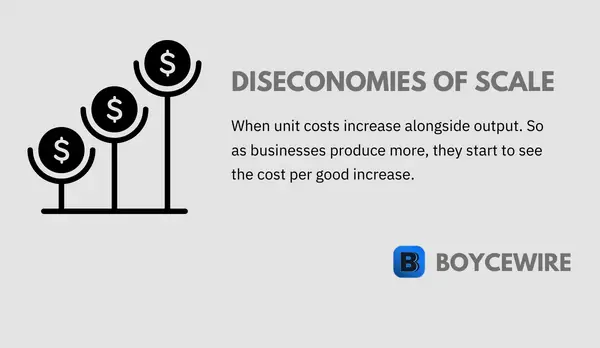
Diseconomies of Scale Definition
Diseconomies of Scale is an economic term that defines the trend for average costs to increase alongside output. At a specific point in production, the process starts to become less efficient. In other words, it starts to cost more to produce an additional unit of output.
In economic jargon, diseconomies of scale occur when average unit costs start to increase. For example, the graph below illustrates that at a point Q1, average costs start to increase.
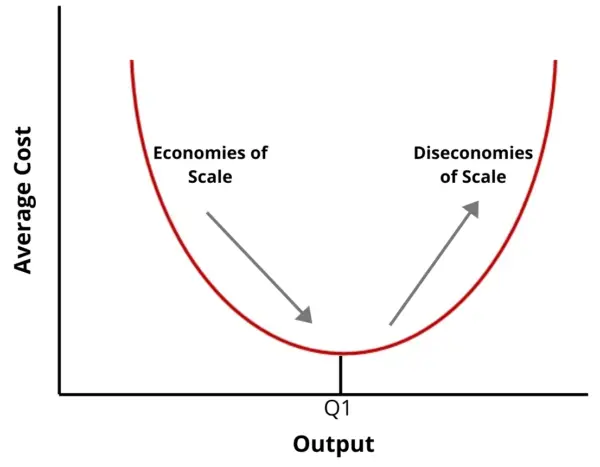
Let us take a quick example.
A coffee shop serves 100 customers an hour and employs 5 people at $15 an hour to do so – which equals $75 per hour. In turn, each employee serves 20 customers.
The coffee shop sees an increase in demand, so there are now 140 customers per hour. The store responds by hiring two new staff members to serve the extra 40 customers. However, the store hasn’t increased in size, so the new staff starts getting in everybody’s way and making orders twice. This subsequently means that they are only able to serve 30 additional customers.
The new workers are only able to serve 30 customers, or 15 each – much lower than the 20 being serviced before. These workers cost the coffee shop an extra $30, which works out as a cost of $1 per customer. This is far lower than the 100 customers served by the 5 other workers at a cost of $75, or $0.75 per customer.
Types of Diseconomies of Scale
Diseconomies of scale can be split into two categories: internal and external. Internal diseconomies are factors that are directly controlled by the firm. For instance, the organizational structure and process management can become too complex if it is not controlled efficiently. This can lead to miscommunication and duplication of work, and therefore, diseconomies of scale.
By contrast, external diseconomies refer to factors that occur outside the firm’s control. For example, the local infrastructure may mean employees get stuck in traffic or suffer from train delays. This may result in staff being late, stressed, and therefore, unproductive.
Internal Diseconomies of Scale
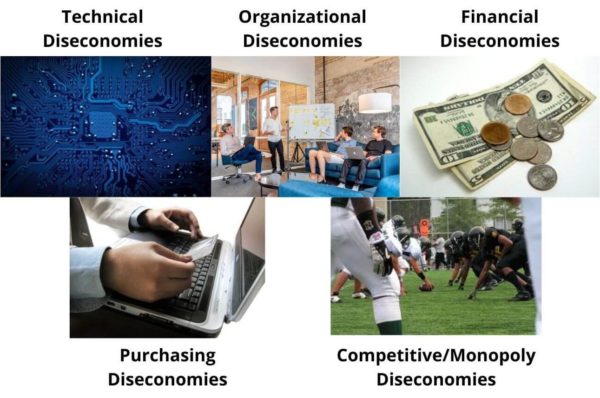
1. Technical Diseconomies of Scale
Technical diseconomies occur during the production process. This may be on the factory line, behind the counter at a cafe, or a worker at the office. In other words, it costs the firm more to produce more goods or services. For instance, a firm may overcrowd its offices or factories beyond reasonable capacity. Subsequently, this overcrowding may lead to inefficiencies in terms of poor staff morale, and staff getting in each other’s way.
We can also think of technical diseconomies as the method of production. So, how the product is made.
Technical diseconomies of scale can happen when a firm grows quicker than it is able to adapt. These generally occur when a firm invests heavily in new capacity. For instance, existing stores may be efficient, which encourages firms to invest in new stores. However, those stores are not necessarily as efficient as the first.
Effects of Technical Diseconomies
Overcrowding
When expanding, the firm may increase production beyond reasonable capacity. This may include putting too many barristers behind the bar at the coffee shop. They may get in each other’s way or end up duplicating work.
Scalability
Although a store may be highly efficient in one location, the firm may expand into another that is not. In turn, the average cost of production increases.
2. Organizational Diseconomies of Scale
Organizational diseconomies occur when a larger workforce becomes more difficult to manage. For example, Mr. Jones owns several bakeries. He hires 5 employees in each of his 10 stores so he now has an additional 50 employees. On his own, it is incredibly difficult to manage and plan the schedules, wages, and other factors for these new workers. In turn, he may have to hire additional managers, accountants, and lawyers, thereby adding to costs.
Simply put, they are inefficiencies that arise with regards to the management of people. Examples include inefficient communication, lack of motivation, greater sick days, lack of responsibility, or ownership of tasks.
Effects of Organizational Diseconomies
Communication
Organisational diseconomies occur when the firm expands. In turn, new departments open alongside new employees. For all involved, it can create a minefield. To get something done, an employee may need to go through various departments to find assistance. The big successful firms tend to resolve such issues. Although some inefficiencies may still occur.
Demotivation
As the firm grows bigger, there are also psychological issues that can arise. For instance, being one of the 500,000 employees can create a feeling of insignificance. Furthermore, managers may easily overlook any individual successes. As a result, employees can feel demotivated, thereby under-performing and creating inefficiencies.
Employee Health
As stated previously, employees can feel like just another cog in the wheel of a big firm. However, big firms can also create a feeling of isolation for many. When there is a set and standard procedure to follow, it can feel rather robotic. This sense of isolation and insignificance not only affects motivation, but also health.
In turn, employees may take off more sick days, become less productive, and also be less innovative.
3. Purchasing Diseconomies
Sometimes, big firms can end up paying more than it would as a small company. If we think of Google, Apple, or Microsoft, they all have significant levels of cash flow. For instance, Apple generates revenues of over $55 billion a year. As a result, it is inevitable that such firms end up overpaying for various goods.
One example includes Apples purchase of Beats back in 2014. It paid $3 billion for the company, despite its valuation being $1.8 billion just a year earlier.
Naturally, if a big firm wants an asset, good, or service, it is willing and able to do so despite the price. This is because it has both the desire and resources – something a smaller firm may not be able to.
Effects of Purchasing Diseconomies
Higher Costs
As firms become increasingly willing to spend more, they are more likely to overpay for goods and services. In turn, this will end up impacting their bottom line.
Greater Waste
As a firm gets bigger, there becomes a disconnect between management and the average employee. Consequently, the needs of the worker are often forgone and overlooked. Management may buy resources employees do not need or want.
Deadlock
Some large firms recognise that there are levels of reckless spending. As a result, purchasing decisions may go through round after round of approval, eventually getting blocked at the last stage. In turn, the firm may not actually progress.
4. Competitive/Monopoly Diseconomies
Strong and competitive markets are key to keeping businesses efficient. When there is little competition, there is less pressure to reduce costs. For instance, a firm that owns a monopoly has little incentive to reduce costs and increase efficiencies as there is no competition that may put it out of business. At the same time, customers do not have an alternative so are forced to pay for the price.
As a result, non-competitive markets tend to have higher costs than under competitive conditions.
Competition can be worn down over time as a firm grows bigger and bigger. For instance, Amazon has grown at a rapid pace and now has a strong position in the eCommerce market. Although it does not have a monopoly, it has little in the way of competition. In turn, such large companies may suffer from inefficiencies if management do not keep on top of the numerous issues that may result. When there is little competition, there is less pressure on management to do so.
Effects of Competitive/Monopoly Diseconomies
More Competition: If the monopolist firm allows itself to become ‘bloated’ and inefficient, new firms may spot an opportunity to enter the market. In addition, high profits with large costs, acts as a signal to potential competitors.
Higher Costs: Companies that have significant market share usually have thousands of employees. As a result of its strong positioning, it may find management does not have the same incentives to implement universal efficiencies within the firm.
5. Financial Diseconomies
As a firm grows bigger, it may look to buy new factories or real estate. In turn, it will require new sources of funding. If these are no organically raised, they will come from external sources such as banks or other financial instruments. As a result, the firm will have to repay interest. This creates an additional cost that smaller firms do not always have.
As costs of financing increases, so too do the costs of managing financial records. More accountants and legal teams may be required. In turn, the final cost of production can increase if productivity does not grow over and above these costs.
Effects of Financial Diseconomies
Expanded Workforce: Borrowing more assets requires more employees to oversee the finances, as well as to manage those resources. As the firm needs to hire more workers, it may also need to borrow more.
High Levels of Interest: When a firm uses external finance to grow inorganically, it can become increasingly expensive to continue. The more a firm borrows, the riskier it becomes for investors. In turn, lenders account for the risk with higher interest rates.
External Diseconomies of Scale
External diseconomies refer to costs that increase due to factors outside of the company but impact the whole industry. In other words, as the industry grows, diseconomies impact the firm as well as the wider industry.
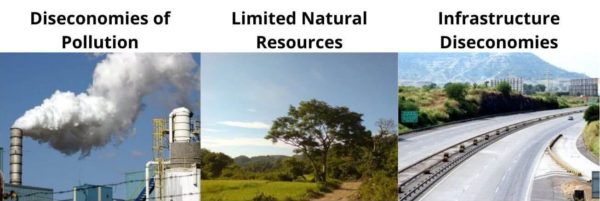
1. Diseconomies of Pollution
As an industry grows larger, it can create additional costs to the local or national population. For example, several factories may open in close proximity to each other in order to benefit from efficiencies. This may come from knowledge efficiencies, supplier efficiencies, or other such efficiencies. As a result, such factories may create additional costs in the form of pollution to its local surroundings. Often this can lead to severe respiratory illnesses to local residents.
Pollution is not a cost that is necessarily borne by the company, but it can have a heavy cost to both employees and local residents. This could come in the form of air and noise pollution. For instance, a new airport built may create a cost onto a third party in the form of noise pollution. As a result, house prices may be negatively affected.
Effects of Diseconomies of Pollution
Poor Health: Air pollution is known for its potential effects on respiratory health. Furthermore, there are other long-term side effects such as heart disease, lung cancer, and damage to peoples nerves, brain, kidneys, and other organs.
Lower House Prices: Areas that are more prone to air and noise pollution may lose value over time. For example, a new airport may cause significant noise pollution to local residents, thereby creating a dis-incentive for the next buyer of the property.
2. Limited Natural Resources
All industries require a number of natural resources. These could range from labour, to land, to physical resources, such as coal. As an industry grows larger, it uses more and more resources. In turn, the existing resources become rarer and more expensive.
Skilled labour in the STEM subjects are notably in short supply. For companies hiring such workers, it is difficult to attract them from a limited supply, so they offer higher salaries. As a result, the cost of production increases.
Another example can include the extraction of natural resources such as coal, oil, or gold. There is only a set supply, so when this becomes rarer, it also becomes more costly to find and extract. In turn, prices go up to make it more profitable and worthwhile to extract resources that are more difficult to reach. For instance, oil fields in the middle of the ocean can be a logistic and financial nightmare.
As the industry grows larger, these resources become scarcer, which can put financial pressure on the firms. This may put some competitors out of business, or, the firms may pass on the costs to the consumer.
Effects of Limited Natural Resources
Higher Prices to the Consumer
As a natural resource becomes rarer, it is inevitable that higher prices will result.
Higher Salaries: For workers that are in short supply, it could mean higher salaries in the long run.
3. Infrastructure Diseconomies
Infrastructure diseconomies occur when an industry grows so large that it starts to put a strain on local infrastructure. For instance, roads may become congested or trains are can become un-functional.
To be sure, certain industries are prone to infrastructure diseconomies than others. Notable examples include freighting, taxis, and retail. When it takes an extra hour to deliver goods to the store, it adds an extra cost to the final product.
Diseconomies of Scale Examples
We have already discussed the types of diseconomies and some examples, but let us summarise them below:
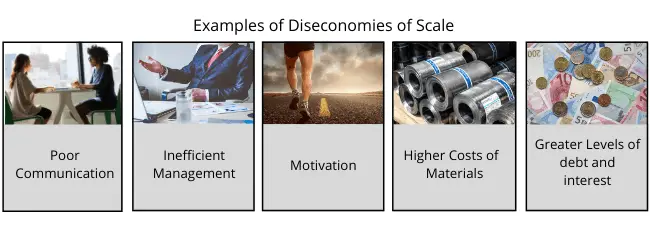
1. Poor Communication
As a firm grows, it acquires more workers and creates more departments. In turn, it can make it difficult to contact the right person for the right task. It often becomes common practice to communicate via email, which can allow crucial details to be overlooked. When departments are located across the country, it can be easier to just send an email, but it can often lead to misunderstandings and costly mistakes.
2. Inefficient Management
When firms grow quickly, there is a tendency for management to be put in place because they are good at their job rather than their management skills. There are a certain number of tasks managers need to do such as keeping morale high and overlooking staff. Yet this is not always a priority. Management may get promoted as they are good at their job, but don’t always receive the necessary training to transition into management. As a result, staff are not always as efficient as they could be.
3. Motivation
Being part of a company of over 10,000 or in an office of hundreds can create a feeling of isolation. Furthermore, management may not necessarily give the same level of praise or attention as a smaller firm. It’s difficult for managers in a big firm to keep track on how all of their delegates are doing. They will have their own tasks and responsibilities, and managing their delegates is usually not a top priority. In turn, workers may just feel like another cog in the wheel, leaving them demotivated and inefficient.
4. Higher Costs of Resources
Buying land in New York, London, or another big city has become astronomically expensive. In turn, buying new real estate in these cities can make average costs rise. Yet for some businesses, it is necessary to move to such cities in order to expand and attract the necessary talent. Similarly, as oil becomes rare, it also becomes more expensive to find and extract.
5. Greater Levels of debt and interest
When a firm grows, it often takes on sizeable levels of debt. For example, Apple had over $98 billion in debt in 2020. With such levels of debt, there are also interest payments that need to be made – another cost that can impact final costs if investments do not create sufficient productivity gains.
Difference between Economies of Scale and Diseconomies of Scale
Diseconomies of scale refer to increasing average costs alongside higher levels of output. In other words, the cost of production starts to become more expensive. By contrast, economies of scale refer to declining costs when output increases.
The difference between the two is best illustrated below:

At a certain point, the firm starts to become less efficient and the cost of production increases. This is where the company starts to experience diseconomies — at Q1. It occurs when a company reaches a certain size where expansion makes the cost of production increase. Factors include organizational diseconomies, technical, infrastructural, and financial diseconomies.
FAQs on Diseconomies of Scale
Diseconomies of scale are caused by both internal and external factors.
Internal Factors include:
Technical: Method of production. For instance, overcrowding in the office or behind the cashier.
Organizational: Lack of efficient communication between departments as the company grows.
Purchasing: Bad purchasing decisions can be made due to too much cash or bad procurement processes.
Competitive/Monopoly: As a firm gains a strong market position, it can start to become less efficient as there is no competition to take market share.
Financial: High levels of debt.
External Factors include:
Pollution: As a company grows bigger, its CO2 footprint can also increase. However, there are also other types of pollution such as noise and visual that could be considered as a net cost to society.
Limited Natural Resources: Resources such as labour etc. can become more expensive. So if a company requires specific expertise, it may be in short supply. In turn; as the company gets bigger, it requires more and more of these skilled employees that are in limited supply.
Infrastructure: As cities get bigger, they also become more congested. Consequently, this can impact on health factors, such as stress or pollution.
Diseconomies of scale is not necessarily bad. But rather it is an inefficient allocation of resources as it makes goods more expensive than they would be otherwise. This is because the cost to produce it increases the bigger the firm gets.
Economies of scale occurs when the average price to make a product decreases as the company grows. By contrast, diseconomies of scale occurs when the cost to produce the product grows higher, making to more expensive.
About Paul
Paul Boyce is an economics editor with over 10 years experience in the industry. Currently working as a consultant within the financial services sector, Paul is the CEO and chief editor of BoyceWire. He has written publications for FEE, the Mises Institute, and many others.

Further Reading
 Keynesian Economics: Definition & How It’s Used - The basic premise of Keynesian economics is that government intervention should be used to stabilize the economy.
Keynesian Economics: Definition & How It’s Used - The basic premise of Keynesian economics is that government intervention should be used to stabilize the economy.  Degrees of Freedom - Degrees of freedom refers to the number of independent variables or data points that can vary in statistical analysis.
Degrees of Freedom - Degrees of freedom refers to the number of independent variables or data points that can vary in statistical analysis.  Current Assets - Table of Contents What are Current Assets? Understanding Current Assets Current Assets in Financial Accounting How to Calculate Challenges of…
Current Assets - Table of Contents What are Current Assets? Understanding Current Assets Current Assets in Financial Accounting How to Calculate Challenges of… 